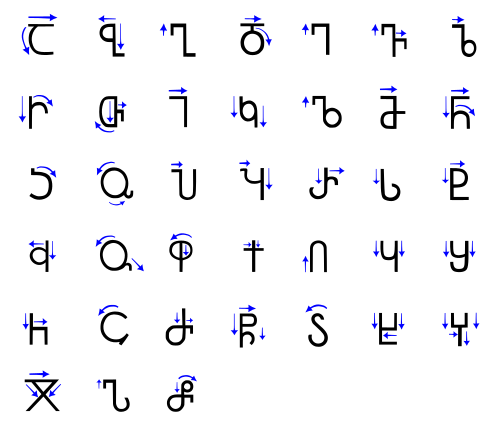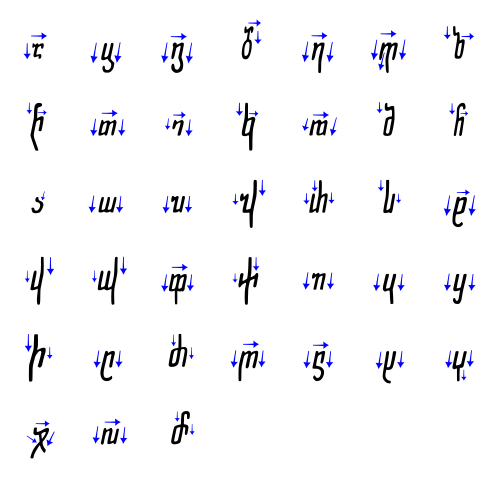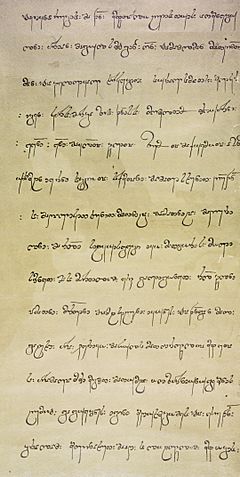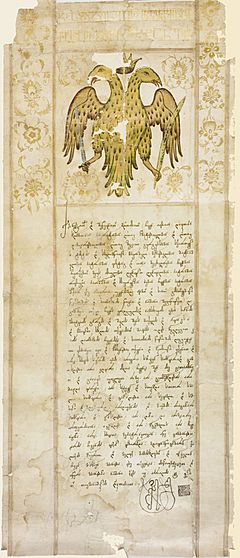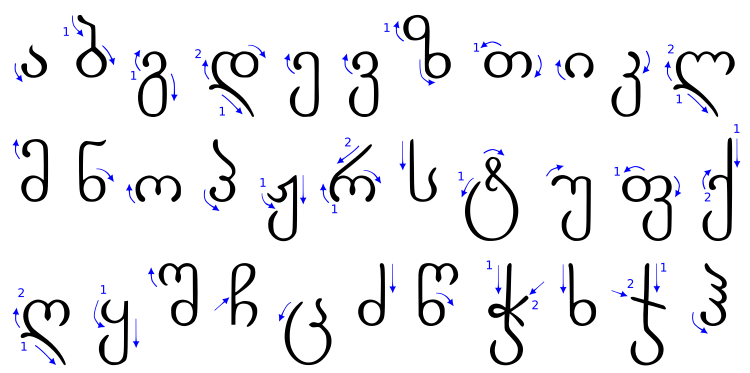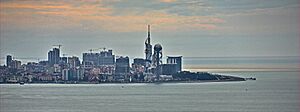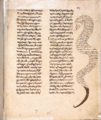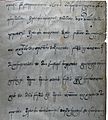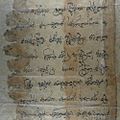Georgian scripts facts for kids
Quick facts for kids Georgian |
|
|---|---|

damts'erloba "script" in Mkhedruli
|
|
| Type | Alphabet |
| Spoken languages | Georgian and other Kartvelian languages |
| Time period | AD 430 – present |
| Parent systems |
Uncertain, alphabetical order modelled on Greek
|
| Unicode range |
|
| ISO 15924 | Geor |
| Note: This page may contain IPA phonetic symbols in Unicode. | |
| Living culture of three writing systems of the Georgian alphabet | |
|---|---|
|
UNESCO Intangible Cultural Heritage
|
|
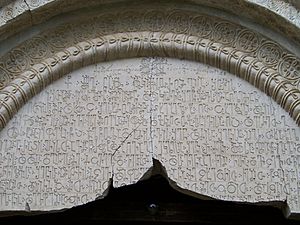 |
|
| Country | Georgia |
| Reference | 01205 |
| Region | |
| Inscription history | |
| Inscription | 2016 (11 session) |
The Georgian scripts are three special ways of writing the Georgian language. These are called Asomtavruli, Nuskhuri, and Mkhedruli. Even though they look different, their letters have the same names and follow the same alphabet order. They are all written from left to right.
Today, Mkhedruli is the main script used for modern Georgian and other related languages. It was once the script for kings and official documents. Asomtavruli and Nuskhuri are mostly used by the Georgian Orthodox Church for religious texts and art.
The Georgian scripts look very unique. We don't know exactly how they started. However, their alphabet order is much like the Greek alphabet. Letters for special Georgian sounds are at the end. The original alphabet had 38 letters. Now, modern Georgian uses 33 letters because five old ones are no longer used. Other related languages, like Mingrelian and Laz, use slightly different numbers of letters.
In 2015, the "living culture of three writing systems of the Georgian alphabet" was recognized as an important cultural heritage in Georgia. In 2016, UNESCO added it to its list of important cultural traditions for all humanity.
Contents
- Discover the Georgian Scripts
- Where Did the Georgian Scripts Come From?
- Asomtavruli: The Oldest Georgian Script
- Nuskhuri: The Second Georgian Script
- Asomtavruli and Nuskhuri Today
- Mkhedruli: The Modern Georgian Script
- Connecting Letters and Short Forms
- How Georgian Scripts Look in Print
- How Punctuation Works
- Summary of Georgian Scripts
- Georgian Scripts for Other Languages
- Georgian Scripts in Computers
- Images for kids
- See also
Discover the Georgian Scripts
Where Did the Georgian Scripts Come From?
The exact beginning of the Georgian script is a bit of a mystery. Experts don't fully agree on when it was created, who made it, or what inspired it.
The oldest known version of the script is Asomtavruli. It dates back to the 5th century. The other scripts came later. Many scholars believe the Georgian script was created when the people of Kartli, a main Georgian kingdom, became Christian. So, the alphabet was likely made between 326 AD and 430 AD. Monks in Georgia and Palestine first used it to translate the Bible and other Christian books into Old Georgian.
Some old Georgian stories say the alphabet is much older. They claim King Pharnavaz I invented it in the 3rd century BC. However, most experts today think this is just a legend. No old evidence has been found to support it.
There's also a debate about whether Armenian religious leaders helped create the Georgian script. Some old Armenian writings say that Mesrop Mashtots, who created the Armenian alphabet, also made the Georgian one. Georgian scholars and some Western experts disagree with this idea.
Another discussion is about what inspired the Georgian alphabet. Was it more like the Greek alphabet or older Middle Eastern alphabets like Aramaic? Recent studies suggest it has more in common with the Greek alphabet. This is especially true for the order and number values of the letters. Some also think old Georgian symbols might have inspired certain letters.
Asomtavruli: The Oldest Georgian Script
Asomtavruli (Georgian: ასომთავრული) is the oldest Georgian script. Its name means "capital letters." This is because aso means "letter" and mtavari means "principal" or "head." It's also called Mrgvlovani (Georgian: მრგვლოვანი), which means "rounded." This name comes from mrgvali meaning "round," because of its round letter shapes. Even though it's called a "capital" script, all its letters are the same height.
The oldest Asomtavruli writings found are from the 5th century. These include the Bir el Qutt inscriptions and the Bolnisi inscriptions.
From the 9th century, the Nuskhuri script became more common. Asomtavruli was used less often. However, you can still find Asomtavruli writings on monuments from the 10th to 18th centuries. In later times, Asomtavruli became more decorative. In many 9th-century Georgian books written in Nuskhuri, Asomtavruli was used for titles and the first letters of chapters. Some books were written entirely in Asomtavruli until the 11th century.
How Asomtavruli Letters Look
In early Asomtavruli, all letters were the same height. Most letters have straight horizontal or vertical lines that meet at right angles. Only one letter, Ⴟ (jani), has sharp angles. Some experts think jani might come from a special symbol for Christ. Others believe its cross-like shape shows the end of the alphabet.
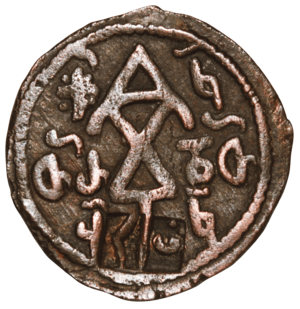
After the 7th century, some letters started to change. They no longer had the same height. Some letters gained parts that went above or below the main line of text.
| Ⴀ ani |
Ⴁ bani |
Ⴂ gani |
Ⴃ doni |
Ⴄ eni |
Ⴅ vini |
Ⴆ zeni |
Ⴡ he |
Ⴇ tani |
Ⴈ ini |
Ⴉ kʼani |
Ⴊ lasi |
Ⴋ mani |
Ⴌ nari |
Ⴢ hie |
Ⴍ oni |
Ⴎ pʼari |
Ⴏ zhani |
Ⴐ rae |
| Ⴑ sani |
Ⴒ tʼari |
Ⴣ vie |
ႭჃ Ⴓ uni |
Ⴔ pari |
Ⴕ kani |
Ⴖ ghani |
Ⴗ qʼari |
Ⴘ shini |
Ⴙ chini |
Ⴚ tsani |
Ⴛ dzili |
Ⴜ ts'ili |
Ⴝ ch'ari |
Ⴞ khani |
Ⴤ qari |
Ⴟ jani |
Ⴠ hae |
Ⴥ hoe |
Decorating Asomtavruli Letters
In books written in Nuskhuri, Asomtavruli letters were used for titles and special decorated first letters. These decorated letters marked the start of new sections. At first, these Asomtavruli letters were just bigger or written in red ink. Later, from the 10th century, they became very fancy.
The style of these decorated letters can help us guess when a text was made. For example, in old Georgian books from the Byzantine era, letters were decorated with birds and other animals. From the 11th century, new decorative styles appeared, like "limb-flowery" and "limb-arrowy." The "limb-spotty" style was used until the 18th century.
The color of the ink was also important. The letter Ⴃ (doni) was often decorated with fish and birds. A "Curly" style of Asomtavruli was also used. In this style, letters were woven together or smaller letters were placed inside bigger ones. This was mostly used for headlines in books.

How to Write Asomtavruli Letters
The table below shows you how to draw each Asomtavruli letter, step by step.
Nuskhuri: The Second Georgian Script
Nuskhuri (Georgian: ნუსხური) is the second Georgian script. The name nuskhuri comes from nuskha, meaning "inventory" or "schedule." Soon, Nuskhuri books started using decorated Asomtavruli letters for important parts. This mix of Nuskhuri and Asomtavruli is called Khutsuri (Georgian: ხუცური), meaning "clerical." It was mainly used for religious writings about saints.
Nuskhuri first appeared in the 9th century. It was a different way of writing Asomtavruli. The oldest Nuskhuri writing is from 835 AD, found in the Ateni Sioni Church. The oldest surviving Nuskhuri books are from 864 AD. By the 10th century, Nuskhuri became more popular than Asomtavruli.
How Nuskhuri Letters Look
Nuskhuri letters are not all the same height. Some parts go above or below the main line. They are also slanted to the right. The letters have sharp, angular shapes. They are simpler than Asomtavruli letters, which made them faster to write.
![]() →
→ ![]()
![]() →
→ ![]() A combination of Asomtavruli letters ⴍ (oni) and ⴣ (vie) created a new letter in Nuskhuri, ⴓ uni.
A combination of Asomtavruli letters ⴍ (oni) and ⴣ (vie) created a new letter in Nuskhuri, ⴓ uni.
| ⴀ ani |
ⴁ bani |
ⴂ gani |
ⴃ doni |
ⴄ eni |
ⴅ vini |
ⴆ zeni |
ⴡ he |
ⴇ tani |
ⴈ ini |
ⴉ kʼani |
ⴊ lasi |
ⴋ mani |
ⴌ nari |
ⴢ hie |
ⴍ oni |
ⴎ pʼari |
ⴏ zhani |
ⴐ rae |
| ⴑ sani |
ⴒ tʼari |
ⴣ vie |
ⴍⴣ ⴓ uni |
ⴔ pari |
ⴕ kani |
ⴖ ghani |
ⴗ qʼari |
ⴘ shini |
ⴙ chini |
ⴚ tsani |
ⴛ dzili |
ⴜ tsʼili |
ⴝ chʼari |
ⴞ khani |
ⴤ qari |
ⴟ jani |
ⴠ hae |
ⴥ hoe |
- Note: Without the right font, you might see question marks or boxes instead of Nuskhuri letters.
How to Write Nuskhuri Letters
This table shows the order and direction of strokes for each Nuskhuri letter.
Asomtavruli and Nuskhuri Today
Today, Asomtavruli is often used in religious art, wall paintings, and stone carvings. In the 1950s, a Georgian linguist tried to use Asomtavruli as capital letters in Mkhedruli, like in English, but it didn't become popular.
Both Asomtavruli and Nuskhuri are still officially used by the Georgian Orthodox Church. The head of the Church, Patriarch Ilia II of Georgia, has encouraged people to use all three Georgian scripts.
Mkhedruli: The Modern Georgian Script
Mkhedruli (Georgian: მხედრული) is the third and current Georgian script. Its name literally means "cavalry" or "military." It comes from the word mkhedari, which means "horseman" or "knight."
Mkhedruli has both small and "capital" letters. The capital letters are called Mkhedruli Mtavruli (Georgian: მხედრული მთავრული) or simply Mtavruli. Today, Mtavruli is mostly used for titles or to make a word stand out, like when you use all capital letters. In the past, in the late 1800s and early 1900s, they were sometimes used like capital letters in English or Russian. Modern Georgian doesn't really use capital letters in the same way, so their use is mostly for decoration.
Mkhedruli first appeared in the 10th century. The oldest Mkhedruli writing is from 982 AD, found in the Ateni Sioni Church. The next oldest texts are royal documents from King Bagrat IV of Georgia in the 11th century. Mkhedruli was mainly used for royal documents, historical records, and other non-religious writings. It was seen as the "civil" or "royal" script.
Mkhedruli became more and more popular than the other two scripts. Even though Khutsuri (Nuskhuri with Asomtavruli) was used until the 19th century, Mkhedruli became the main writing system outside the Church in the 1800s. This happened as printed Georgian books became more common.
How Mkhedruli Letters Look
Early Mkhedruli writings from the 10th and 11th centuries show that the angular shapes of Nuskhuri letters became more rounded. All letters started to have complete outlines. Mkhedruli letters are written within a four-line system, similar to Nuskhuri.
Mkhedruli became rounder and freer to write. It broke away from the strict shapes of Asomtavruli and Nuskhuri. Mkhedruli letters also started to connect more, leading to a more flowing style of writing.
The Modern Georgian Alphabet
The modern Georgian alphabet has 33 letters:
| ა ani |
ბ bani |
გ gani |
დ doni |
ე eni |
ვ vini |
ზ zeni |
თ tani |
ი ini |
კ k'ani |
ლ lasi |
| მ mani |
ნ nari |
ო oni |
პ p'ari |
ჟ zhani |
რ rae |
ს sani |
ტ t'ari |
უ uni |
ფ pari |
ქ kani |
| ღ ghani |
ყ q'ari |
შ shini |
ჩ chini |
ც tsani |
ძ dzili |
წ ts'ili |
ჭ ch'ari |
ხ khani |
ჯ jani |
ჰ hae |
Old Letters No Longer Used in Georgian
The Society for the Spreading of Literacy among Georgians, started by Prince Ilia Chavchavadze in 1879, removed five letters from the Georgian alphabet. These letters were no longer needed.
| ჱ he |
ჲ hie |
ჳ vie |
ჴ qari |
ჵ hoe |
- ჱ (he) sounded like "ey" and was replaced by ეჲ ey or just ე e.
- ჲ (hie) sounded like "y" and was replaced by ი (ini).
- ჳ (vie) sounded like "ui" and was replaced by ვი vi.
- ჴ (qari, hari) sounded like ხ (khani) and was replaced by it.
- ჵ (hoe) was used for the sound "hoi!" and is now spelled ჰოი.
Most of these old letters are still used in the Svan alphabet. The letter ჲ (hie) is also used in the Mingrelian and Laz alphabets.
Letters Added for Other Languages
Mkhedruli has been changed to write other languages besides Georgian. Some of these alphabets kept letters that are no longer used in Georgian. Others needed new letters.
| ჶ fi |
ჷ shva |
ჸ elifi |
ჹ turned gani |
ჺ aini |
ჼ modifier letter nar |
ჽ aen |
ჾ hard sign |
ჿ labial sign |
- ჶ (fi) is used in Laz and Svan. It comes from the Greek letter Φ (phi).
- ჷ (shva) is used for a soft vowel sound in Svan and Mingrelian.
- ჸ (elifi) is used for a quick stop sound in Svan and Mingrelian.
- ჹ (turned gani) was used for a special "g" sound in some religious texts.
- ჼ (modifier nar) is used in Bats to make the vowel before it sound nasal.
- ჺ (aini) is sometimes used in Bats for a special throat sound. It comes from the Arabic letter ʿayn.
- ჽ (aen) was used in the Ossetian language for a soft vowel sound.
- ჾ (hard sign) was used in Abkhaz to change the sound of the letter before it.
- ჿ (labial sign) was used in Abkhaz to make the letter before it sound like it has a "w" after it.
How to Write Mkhedruli Letters
This table shows the order and direction of strokes for each Mkhedruli letter.
The letters ზ, ო, and ხ (zeni, oni, khani) are almost always written without the small tick at the end. The handwritten form of ჯ (jani) often uses a straight vertical line.
- Only four letters stay within the main line of text: ა, თ, ი, ო.
- Thirteen letters have parts that go up, like 'b' or 'd' in English: ბ, ზ, მ, ნ, პ, რ, ს, შ, ჩ, ძ, წ, ხ, ჰ.
- Thirteen letters have parts that go down, like 'p' or 'q' in English: გ, დ, ე, ვ, კ, ლ, ჟ, ტ, უ, ფ, ღ, ყ, ც.
- Three letters have parts that go both up and down: ქ, ჭ, and (in handwriting) ჯ.
Different Ways to Write Mkhedruli Letters
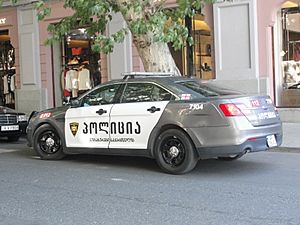
People often write letters slightly differently. For example, the top circle of ზ (zeni) and the top stroke of რ (rae) can go in the opposite direction.
Other common differences:
- გ (gani) can look like ვ (vini) with a closed loop at the bottom.
- დ (doni) is often written with a simple loop at the top.
- კ, ც, and ძ (k'ani, tsani, dzili) are usually written with straight, vertical lines at the top.
- ლ (lasi) is often written with just one curve.
- ო (oni) is rarely written as a right angle.
- რ (rae) is often written with one curve, like a Latin 'h'.
- ტ (t'ari) often has a small circle with a tail inside.
- წ (ts'ili) is usually written with a round shape at the bottom.
- ჭ (ch'ari) can be written without the hook at the top.
- ჱ (he) can be written without the loop.
- ჯ (jani) sometimes looks like a hooked 'X'.
Letters That Look Alike
Some letters look similar and can be confusing, especially when handwritten.
- For ვ (vini) and კ (k'ani), the main difference is if the top is a full curve or a straight line.
- For ვ (vini) and გ (gani), check if the bottom is open or closed. The same applies to უ (uni) and შ (shini).
- For კ (k'ani) and პ (p'ari), the key is whether the letter is written below or above the main line.
- ძ (dzili) is written with a straight top.
Connecting Letters and Short Forms
Asomtavruli letters were often made very fancy. Writers would connect letters, weave them together, or put letters inside other letters to create special designs.

Nuskhuri, like Asomtavruli, was also often written in a very artistic way. Writers would connect letters and use short forms for important religious words. This was helpful because writing materials like vellum (animal skin used for writing) were expensive. By the 11th century, using short forms was very common in books.
From the 11th to 17th centuries, Mkhedruli also started using connected letters so much that it became a rule.

How Georgian Scripts Look in Print
Georgian scripts usually come in one basic style, or "typeface." However, computer programs can make Georgian text look slanted (oblique) or bold. In the past, Asomtavruli was used for chapter titles, similar to how bold or italic text is used in English.
How Punctuation Works
In Asomtavruli and Nuskhuri, different combinations of dots were used to separate words, phrases, and paragraphs. In old writings from the 5th to 10th centuries, these were dashes. In the 10th century, a scholar named Ephrem Mtsire introduced groups of one, two, three, and six dots. These dots showed bigger and bigger breaks in the text. For example, one dot was a small break, and six dots meant the end of a sentence.
From the 11th century, marks like the apostrophe and comma started to appear. An apostrophe marked a question word, and a comma was at the end of a question. Later, in the 12th century, these were replaced by the semicolon (which was like the Greek question mark). In the 18th century, Patriarch Anton I of Georgia changed the system again. He used commas, single dots, and double dots for different types of sentences. Today, Georgian mostly uses punctuation like in English.
Summary of Georgian Scripts

This table shows the three scripts side-by-side. It includes letters that are no longer used in any alphabet (blue background). It also shows letters no longer used in Georgian but still used in other alphabets (green background). Plus, it lists extra letters used in languages other than Georgian (pink background). The table also shows the old number values of the letters.
| Letters | Unicode (mkhedruli) |
Name | IPA | Transcriptions | Numeric value |
||||||
|---|---|---|---|---|---|---|---|---|---|---|---|
| asomtavruli | nuskhuri | mkhedruli | mtavruli | National | ISO 9984 | BGN | Laz | ||||
| Ⴀ | ⴀ | ა | Ა | U+10D0 | ani | /ɑ/, Svan /a, æ/ | A a | A a | A a | A a | 1 |
| Ⴁ | ⴁ | ბ | Ბ | U+10D1 | bani | /b/ | B b | B b | B b | B b | 2 |
| Ⴂ | ⴂ | გ | Გ | U+10D2 | gani | /ɡ/ | G g | G g | G g | G g | 3 |
| Ⴃ | ⴃ | დ | Დ | U+10D3 | doni | /d/ | D d | D d | D d | D d | 4 |
| Ⴄ | ⴄ | ე | Ე | U+10D4 | eni | /ɛ/ | E e | E e | E e | E e | 5 |
| Ⴅ | ⴅ | ვ | Ვ | U+10D5 | vini | /v/ | V v | V v | V v | V v | 6 |
| Ⴆ | ⴆ | ზ | Ზ | U+10D6 | zeni | /z/ | Z z | Z z | Z z | Z z | 7 |
| Ⴡ | ⴡ | ჱ | Ჱ | U+10F1 | he | /eɪ/, Svan /eː/ | — | Ē ē | Ey ey | — | 8 |
| Ⴇ | ⴇ | თ | Თ | U+10D7 | tani | /t⁽ʰ⁾/ | T t | Tʼ tʼ | Tʼ tʼ | T t | 9 |
| Ⴈ | ⴈ | ი | Ი | U+10D8 | ini | /i/ | I i | I i | I i | I i | 10 |
| Ⴉ | ⴉ | კ | Კ | U+10D9 | kʼani | /kʼ/ | Kʼ kʼ | K k | K k | Ǩ ǩ | 20 |
| Ⴊ | ⴊ | ლ | Ლ | U+10DA | lasi | /l/ | L l | L l | L l | L l | 30 |
| Ⴋ | ⴋ | მ | Მ | U+10DB | mani | /m/ | M m | M m | M m | M m | 40 |
| Ⴌ | ⴌ | ნ | Ნ | U+10DC | nari | /n/ | N n | N n | N n | N n | 50 |
| Ⴢ | ⴢ | ჲ | Ჲ | U+10F2 | hie | /je/, Mingrelian, Laz, & Svan /j/ | — | Y y | J j | Y y | 60 |
| Ⴍ | ⴍ | ო | Ო | U+10DD | oni | /ɔ/, Svan /ɔ, œ/ | O o | O o | O o | O o | 70 |
| Ⴎ | ⴎ | პ | Პ | U+10DE | pʼari | /pʼ/ | Pʼ pʼ | P p | P p | P̌ p̌ | 80 |
| Ⴏ | ⴏ | ჟ | Ჟ | U+10DF | zhani | /ʒ/ | Zh zh | Ž ž | Zh zh | J j | 90 |
| Ⴐ | ⴐ | რ | Რ | U+10E0 | rae | /r/ | R r | R r | R r | R r | 100 |
| Ⴑ | ⴑ | ს | Ს | U+10E1 | sani | /s/ | S s | S s | S s | S s | 200 |
| Ⴒ | ⴒ | ტ | Ტ | U+10E2 | tʼari | /tʼ/ | Tʼ tʼ | T t | T t | Ť t̆ | 300 |
| Ⴣ | ⴣ | ჳ | Ჳ | U+10F3 | vie | /uɪ/, Svan /w/ | — | W w | — | — | 400 |
| Ⴓ | ⴓ | უ | Უ | U+10E3 | uni | /u/, Svan /u, y/ | U u | U u | U u | U u | 400 |
| Ⴧ | ⴧ | ჷ | Ჷ | U+10F7 | yn, schva | Mingrelian & Svan /ə/ | — | — | — | — | — |
| Ⴔ | ⴔ | ფ | Ფ | U+10E4 | pari | /p⁽ʰ⁾/ | P p | Pʼ pʼ | Pʼ pʼ | P p | 500 |
| Ⴕ | ⴕ | ქ | Ქ | U+10E5 | kani | /k⁽ʰ⁾/ | K k | Kʼ kʼ | Kʼ kʼ | K k | 600 |
| Ⴖ | ⴖ | ღ | Ღ | U+10E6 | ghani | /ɣ/ | Gh gh | Ḡ ḡ | Gh gh | Ğ ğ | 700 |
| Ⴗ | ⴗ | ყ | Ყ | U+10E7 | qʼari | /qʼ/ | Qʼ qʼ | Q q | Q q | Q q | 800 |
| — | — | ჸ | Ჸ | U+10F8 | elif | Mingrelian & Svan /ʔ/ | — | — | — | — | — |
| Ⴘ | ⴘ | შ | Შ | U+10E8 | shini | /ʃ/ | Sh sh | Š š | Sh sh | Ş ş | 900 |
| Ⴙ | ⴙ | ჩ | Ჩ | U+10E9 | chini | /tʃ⁽ʰ⁾/ | Ch ch | Čʼ čʼ | Chʼ chʼ | Ç ç | 1000 |
| Ⴚ | ⴚ | ც | Ც | U+10EA | tsani | /ts⁽ʰ⁾/ | Ts ts | Cʼ cʼ | Tsʼ tsʼ | Ʒ ʒ | 2000 |
| Ⴛ | ⴛ | ძ | Ძ | U+10EB | dzili | /dz/ | Dz dz | J j | Dz dz | Ž ž | 3000 |
| Ⴜ | ⴜ | წ | Წ | U+10EC | tsʼili | /tsʼ/ | Tsʼ tsʼ | C c | Ts ts | Ǯ ǯ | 4000 |
| Ⴝ | ⴝ | ჭ | Ჭ | U+10ED | chʼari | /tʃʼ/ | Chʼ chʼ | Č č | Ch ch | Ç̌ ç̌ | 5000 |
| Ⴞ | ⴞ | ხ | Ხ | U+10EE | khani | /χ/ | Kh kh | X x | Kh kh | X x | 6000 |
| Ⴤ | ⴤ | ჴ | Ჴ | U+10F4 | qari, hari | /q⁽ʰ⁾/ | — | H̱ ẖ | qʼ | — | 7000 |
| Ⴟ | ⴟ | ჯ | Ჯ | U+10EF | jani | /dʒ/ | J j | J̌ ǰ | J j | C c | 8000 |
| Ⴠ | ⴠ | ჰ | Ჰ | U+10F0 | hae | /h/ | H h | H h | H h | H h | 9000 |
| Ⴥ | ⴥ | ჵ | Ჵ | U+10F5 | hoe | /oː/, Bats /ʕ, ɦ/ | — | Ō ō | — | — | 10000 |
| — | — | ჶ | Ჶ | U+10F6 | fi | Laz /f/ | — | F f | — | F f | — |
| — | — | ჹ | Ჹ | U+10F9 | turned gani | Dagestanian languages /ɢ/ in evangelical literature | — | — | — | — | — |
| — | — | ჺ | Ჺ | U+10FA | aini | Bats /ʕ/ | — | — | — | — | — |
| — | — | ჼ | — | U+10FC | modifier nar | Bats /◌̃/ nasalization of preceding vowel | — | — | — | — | — |
| Ⴭ | ⴭ | ჽ | Ჽ | U+10FD | aen | Ossetian /ə/ | — | — | — | — | — |
| — | — | ჾ | Ჾ | U+10FE | hard sign | Abkhaz velarization of preceding consonant | — | — | — | — | — |
| — | — | ჿ | Ჿ | U+10FF | labial sign | Abkhaz labialization of preceding consonant | — | — | — | — | — |
Georgian Scripts for Other Languages
The Georgian script has been used to write several languages that are not related to Georgian.
- Ossetian language until the 1940s.
- Abkhaz language until the 1940s.
- Ingush language (in the past), later changed to Arabic and then Cyrillic script.
- Chechen language (in the past), later changed to Arabic and then Cyrillic script.
- Avar language (in the past), later changed to Arabic and then Cyrillic script.
- Turkish language and Azerbaijani language. There are Turkish Gospels, dictionaries, and poems from the 18th century written in Georgian script.
- Persian language. An 18th-century Persian translation of an Arabic Gospel is kept in Tbilisi.
- Armenian language. In the 18th and 19th centuries, the Georgian script was sometimes used to write Armenian in Tbilisi.
- Russian language. Some short Russian poems from the late 18th and early 19th centuries are written in Georgian script.
- Other Northeast Caucasian languages. Georgian script was used for these languages due to Georgian missionary work starting in the 18th century.
Georgian Scripts in Computers
The first Georgian script was added to the Unicode Standard in 1991. Unicode helps computers show text correctly from different languages. Experts like Jost Gippert and Michael Everson played important roles in creating the Georgian Unicode block.
Georgian Mkhedruli script is officially used for Georgia's internet addresses (like website names) that end in (.გე).
Mtavruli letters were added to Unicode in 2018. These are like capital letters for Mkhedruli. Before this, computer fonts showed Mtavruli in different ways.
Unicode Blocks for Georgian Scripts
Georgian characters are found in three Unicode blocks:
- The first block (U+10A0–U+10FF) is called Georgian. It has Mkhedruli (modern Georgian) and Asomtavruli.
- The second block (U+2D00–U+2D2F) is the Georgian Supplement. It contains Nuskhuri.
- The third block (U+1C90–U+1CBF) is the Georgian Extended block. It has Mtavruli capitals.
Mtavruli is the uppercase form of Mkhedruli. Asomtavruli is the uppercase form of Nuskhuri.
| Georgian[1][2] Official Unicode Consortium code chart: https://www.unicode.org/charts/PDF/U10A0.pdf (PDF) |
||||||||||||||||
| 0 | 1 | 2 | 3 | 4 | 5 | 6 | 7 | 8 | 9 | A | B | C | D | E | F | |
| U+10Ax | Ⴀ | Ⴁ | Ⴂ | Ⴃ | Ⴄ | Ⴅ | Ⴆ | Ⴇ | Ⴈ | Ⴉ | Ⴊ | Ⴋ | Ⴌ | Ⴍ | Ⴎ | Ⴏ |
| U+10Bx | Ⴐ | Ⴑ | Ⴒ | Ⴓ | Ⴔ | Ⴕ | Ⴖ | Ⴗ | Ⴘ | Ⴙ | Ⴚ | Ⴛ | Ⴜ | Ⴝ | Ⴞ | Ⴟ |
| U+10Cx | Ⴠ | Ⴡ | Ⴢ | Ⴣ | Ⴤ | Ⴥ | Ⴧ | Ⴭ | ||||||||
| U+10Dx | ა | ბ | გ | დ | ე | ვ | ზ | თ | ი | კ | ლ | მ | ნ | ო | პ | ჟ |
| U+10Ex | რ | ს | ტ | უ | ფ | ქ | ღ | ყ | შ | ჩ | ც | ძ | წ | ჭ | ხ | ჯ |
| U+10Fx | ჰ | ჱ | ჲ | ჳ | ჴ | ჵ | ჶ | ჷ | ჸ | ჹ | ჺ | ჻ | ჼ | ჽ | ჾ | ჿ |
| Notes | ||||||||||||||||
| Georgian Supplement[1][2] Official Unicode Consortium code chart: https://www.unicode.org/charts/PDF/U2D00.pdf (PDF) |
||||||||||||||||
| 0 | 1 | 2 | 3 | 4 | 5 | 6 | 7 | 8 | 9 | A | B | C | D | E | F | |
| U+2D0x | ⴀ | ⴁ | ⴂ | ⴃ | ⴄ | ⴅ | ⴆ | ⴇ | ⴈ | ⴉ | ⴊ | ⴋ | ⴌ | ⴍ | ⴎ | ⴏ |
| U+2D1x | ⴐ | ⴑ | ⴒ | ⴓ | ⴔ | ⴕ | ⴖ | ⴗ | ⴘ | ⴙ | ⴚ | ⴛ | ⴜ | ⴝ | ⴞ | ⴟ |
| U+2D2x | ⴠ | ⴡ | ⴢ | ⴣ | ⴤ | ⴥ | ⴧ | ⴭ | ||||||||
| Notes | ||||||||||||||||
| Georgian Extended[1][2] Official Unicode Consortium code chart: https://www.unicode.org/charts/PDF/U1C90.pdf (PDF) |
||||||||||||||||
| 0 | 1 | 2 | 3 | 4 | 5 | 6 | 7 | 8 | 9 | A | B | C | D | E | F | |
| U+1C9x | Ა | Ბ | Გ | Დ | Ე | Ვ | Ზ | Თ | Ი | Კ | Ლ | Მ | Ნ | Ო | Პ | Ჟ |
| U+1CAx | Რ | Ს | Ტ | Უ | Ფ | Ქ | Ღ | Ყ | Შ | Ჩ | Ც | Ძ | Წ | Ჭ | Ხ | Ჯ |
| U+1CBx | Ჰ | Ჱ | Ჲ | Ჳ | Ჴ | Ჵ | Ჶ | Ჷ | Ჸ | Ჹ | Ჺ | Ჽ | Ჾ | Ჿ | ||
| Notes | ||||||||||||||||
Georgian Keyboard Layouts
Below is the standard Georgian keyboard layout. This is the traditional way Georgian typewriters were set up.
| “ „ |
1 ! |
2 ? |
3 № |
4 § |
5 % |
6 : |
7 . |
8 ; |
9 , |
0 / |
- _ |
+ = |
← Backspace |
| Tab key | ღ | ჯ | უ | კ | ე ჱ | ნ | გ | შ | წ | ზ | ხ ჴ | ც | ) ( |
| Caps lock | ფ ჶ | ძ | ვ ჳ | თ | ა | პ | რ | ო | ლ | დ | ჟ | Enter key ↵ |
| Shift key ↑ |
ჭ | ჩ | ყ | ს | მ | ი ჲ | ტ | ქ | ბ | ჰ ჵ | Shift key ↑ |
| Control key | Win key | Alt key | Space bar | AltGr key | Win key | Menu key | Control key | |
Images for kids
-
Ხანმეტი ოთხთავი.png
Asomtavruli of the 6th and 7th centuries
-
Asomtavruli inscription at Nikortsminda Cathedral
-
Საღმრთოჲ ჟამის წირვაჲ წმიდისა იოვანე ოქროპირისაჲ.jpg
Nuskhuri of 8th to 10th centuries
-
Მცირე სჯულისკანონი.png
Nuskhuri of the 11th century
-
Mkhedruli royal charter of King Bagrat IV of Georgia
-
Დავით აღმაშენებლის ავტოგრაფი autograph of georgian king David IV aghmashenebeli.jpg
Mkhedruli royal charter of King David IV of Georgia
-
Გიორგი III-ის სიგელი 1170 წ..jpg
Mkhedruli royal charter of King George III of Georgia
-
Mkhedruli royal charter of Queen Tamar of Georgia
See also
 In Spanish: Alfabeto georgiano para niños
In Spanish: Alfabeto georgiano para niños







